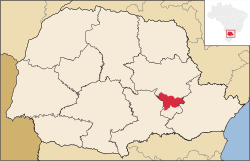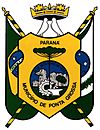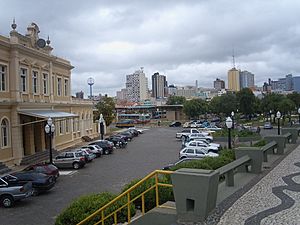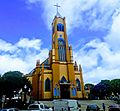Ponta Grossa facts for kids
Quick facts for kids
Ponta Grossa, Paraná
|
|||
|---|---|---|---|
|
City
|
|||

Cup of Vila Velha, postcard of the city
|
|||
|
|||
| Nickname(s):
Princesa dos Campos
Capital Cívica do Paraná |
|||

Location of Ponta Grossa
|
|||
| Country | |||
| Region | South | ||
| State | |||
| Historic countries | |||
| Settled (town) | 15 September 1823 | ||
| Incorporated (city) | 24 March 1862 | ||
| Government | |||
| • Type | City hall | ||
| Area | |||
| • City | 2,067.6 km2 (798.65 sq mi) | ||
| • Urban | 172.41 km2 (6,658,72 sq mi) | ||
| Elevation | 975 m (3,199 ft) | ||
| Population
(2010)
|
|||
| • City | 311,611 | ||
| • Estimate
(2018)
|
348,043 | ||
| • Rank | 77th, Brazil 4th, Paraná |
||
| • Density | 150.55/km2 (388/sq mi) | ||
| • Urban | 304,733 | ||
| • Metro | 430,075 | ||
| population of the Microregion of Ponta Grossa which covers four towns | |||
| Demonym(s) | pontagrossense princesino |
||
| GDP | |||
| • Year | 2015 estimate | ||
| • Total | R$11,805,538.69 thousands (7th, Paraná) | ||
| • Per capita | R$34,941.59 (63rd, Paraná) | ||
| HDI | |||
| • Year | 2010 | ||
| • Category | 0.763 very high (19th), Paraná) | ||
| Time zone | UTC-3 (BRT) | ||
| • Summer (DST) | UTC-2 (BRST) | ||
| Postalcode (CEP) |
84010-000
|
||
| Area codes | +55 42 | ||
| State Highways | PR-151 and PR-513 | ||
| Federal Highway | BR-376 | ||
| Municipality Code | 4119905 | ||
| Website | pontagrossa.pr.gov.br (Portuguese) |
||
Ponta Grossa is a cool city in Brazil. It is located in the southern part of the country. This city is in the state of Paraná. With over 300,000 people, it is the fourth most populated city in Paraná.
Nature and Parks
Ponta Grossa is home to the Parque Estadual da Vila Velha. This means "State Park of Old Town." It is a special park with amazing rocky formations. These rocks were shaped over millions of years by nature. They look like giant sculptures!
Fun Festivals
Another exciting thing about Ponta Grossa is the Münchenfest. This is a big festival that celebrates traditional drinks and culture. It features national and international concerts. The festival lasts a whole week. It usually happens in late November and early December. It's a great time for music and fun!
Images for kids
-
The Saudade Railway Station opened in 1900. It has beautiful neoclassical and art-nouveau designs.
-
Cherry trees can grow well here. This shows they can survive in a subtropical climate.
-
Barão do Rio Branco is a central square. It has many plants and some Araucaria angustifolia trees.
-
These are Sandstone formations in the Vila Velha State Park. People sometimes call it the "City of Lost Stones." It looks like an ancient city in ruins.
-
This is the Polish Church. It was built in 1898. As more immigrants arrived, another church was built in 1928. That one was in the Gothic style.
See also
 In Spanish: Ponta Grossa para niños
In Spanish: Ponta Grossa para niños





















